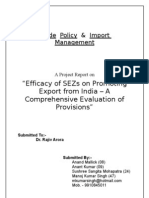Special Economic Zones - Will India's Experiment Succeed?
Special Economic Zones - Will India's Experiment Succeed?
Uploaded by
Mangaram RamaswamyCopyright:
Available Formats
Special Economic Zones - Will India's Experiment Succeed?
Special Economic Zones - Will India's Experiment Succeed?
Uploaded by
Mangaram RamaswamyOriginal Title
Copyright
Available Formats
Share this document
Did you find this document useful?
Is this content inappropriate?
Copyright:
Available Formats
Special Economic Zones - Will India's Experiment Succeed?
Special Economic Zones - Will India's Experiment Succeed?
Uploaded by
Mangaram RamaswamyCopyright:
Available Formats
Special Economic Zones Will Indias experiment succeed?
? The remarkable difference in export performance of China vis--vis India over the last two decades has compelled India to look at its northern neighbour for successful strategies. One of the key strategies leading to the Chinese success was setting up of Special Economic Zones (SEZs) since 1980. SEZs became the drivers of Chinas massive export surge and today, the 5 major Chinese SEZs account for a cumulative FDI of approx. $70 Billion, generate 20% of Chinas total exports and provide direct employment to over 8 Million people. Indias first tryst with Export Processing Zones (EPZ) was in form of Kandla EPZ in 1965 and then subsequently Santa Cruz (SEEPZ) in 1976, much before the advent of SEZs in China. However, Indias EPZs never really took off in the face of an unclear policy, poor infrastructure and inadequate incentives to attract investment. In 2000, the Indian Government finally announced a SEZ policy based on Chinas model. The eight existing EPZs were converted into SEZs, a slew of tax incentives were extended and relaxations on the applicability of various restrictive laws were granted to these SEZs. Importantly, a clear cut policy framework for SEZs was laid down, private investment was invited for setting up of SEZs and states were encouraged to enact legislation to encourage the creation of SEZs. Since 2000, the Government and the RBI have focused on strengthening the policy framework with several policy announcements being made in the interim years. Various states have also come up with state level SEZ Acts and notifications. Although the incentives provided by the government have led to the formation of 14 functional SEZs with an additional currently under implementation, the take-off has not been as smooth as expected. SEZ Investments have been low, a number of teething issues have cropped up and the export performance has been lacklustre. Investors have complained that although the SEZ reforms were a move in the right direction, they were half hearted, wherein several important issues were left unaddressed. There was renewed hope for the languishing SEZs when the Finance Minister announced in his budget speech that the current Government also viewed SEZs as significant growth engines for boosting exports and that that it would be introducing the SEZ Bill in Parliament shortly. The minister went on to express his confidence in the fact that the passing of the law would be a significant milestone in the countrys quest to emerge as a major hub for exports. The introduction of the bill will be a much needed measure to increase the confidence of the investors. With the passage of the bill, it would become the central legislation, hence governing the income tax, customs and excise laws for SEZs and any concessions granted therein cannot be altered without the approval of the Cabinet and Parliament. A reading of the provisions of the draft SEZ bill put up by the Ministry of Commerce also gives cause for optimism. The proposed bill provides for setting up special courts and a separate enforcement agency to check economic offences in SEZs. This shall hopefully allay the fears of the foreign investors regarding Indias chronically slow and unwieldy judicial system. The bill provides for exemption from certain provisions of the Stamp Act and would also permit international insurance companies to offer insurance in the SEZs. Offshore Banking Units (OBUs) would be encouraged with a full tax exemption for five years and 50% exemption thereafter. The applicable rate of tax for OBUs has also been fixed as 5%. Though, these measures are indeed heartening, there are certain key issues that need to be addressed by the government to make the SEZs successful. An important issue has been the failure of the government to address the critical issue of labour reforms. The plethora of labour laws facing an investor wanting to set up a manufacturing facility in India is indeed daunting. A
step has been made by several states with the setting up single point clearances system and providing for minimum inspections requirement, along with delegating powers of the Labour commissioner to the Development Commissioner of each SEZ. However, on the crucial issue of laws relating to retrenchment of labour there has been no development. In fact, the World Economic Forums latest global competitiveness report ranks India 96th out of 102 countries on hiring and firing policies. The current government depends on the Communists for support hence any major labor reforms seem unlikely. However with the increasing unemployment in the country, it may be a good idea to use the SEZs as laboratories to gauge the impact of change in labour laws, and if proved successful, it could herald the way for the rest of the country. Past experience with EPZs have shown that fiscal incentives alone are not sufficient and adequate infrastructure facilities play a very critical role. Although, much is being made of the inadequate infrastructure in the country, the efforts towards addressing the issues are grossly inadequate. The loss in terms of export competitiveness is directly visible in most areas, for e.g. freight payments as a percentage of total import value is 11% for India as compared with a global average of 6%. Apart from higher costs, the inefficiency of port infrastructure also results in a higher lead-time, e.g. lead time for Indias trade with the US is 6-12 weeks in comparison to Chinas 2-3 weeks. In addition to the overall infrastructure disadvantage, the infrastructure in the SEZs currently under development also appears inadequate. In comparison to Chinas SEZs which are spread across over huge land area with a small SEZ such as Pudong being spread over 130,000 acres, the largest Indian Greenfield SEZ project is spread across an area of 7,500 acres. On the investment front, India is investing approx. $1.5 Billion, which in comparison to China is approx th 1/10 of Chinas investment in its smallest SEZ, needless to add, these levels of investment are grossly insufficient to create a world class infrastructure. One of the critical action points for the government would be to ease and fasten the process of land acquisition for the SEZs by framing adequate legislation in this regard. Also considering the heavy investments required, a large government backing for the development of the new SEZs might prove to be useful in creating world class infrastructure. In the context of more than 800 EPZs across the World, it is even more imperative for the Indian SEZs to be positioned & focused appropriately. A possible solution would be to build a have a hub-spoke mechanism for SEZs, wherein large hub SEZs, with large investments are developed with good port facilities and transport linkages catering to industries requiring heavy infrastructure, whereas other smaller SEZs requiring lower investment are created along the hinterland on basis of location advantage & economies of scale are linked to these large industry specialized SEZs. One of the major reasons attributable to the success of Chinese SEZs was their smart targeting of the industrialized markets of Hong-Kong, Macau and Taiwan. Offering a value proposition derived from lower costs ensured huge amounts of investment from these markets. Without a well defined value proposition achieved through focused targeting, it appears highly unlikely that the Indian SEZs could emulate the explosive growth of their Chinese counterparts. At the moment, the government seems to be headed for the correct path and indeed the SEZ Act will be a milestone in this process. However, if the will and resolve for tough measures and crucially the speed of these reforms are found lacking, Indias SEZs may end-up the same fate of its EPZs.
Links / Information on Special Economic Zones (SEZs) a) World Outlook Presentation by Kishore Rao, Bearing Point Inc. on April 29, 2004 in the IFC/FIAS conference, describing different types of trade zones and shares the global experience on SEZs and the best practices that have evolved. The presentation is available in the knowledge base section. b) Financing SEZs in China Presentation by Dr. Jingjing Xu, Managing Partner, GFC-China Holdings on April 29, 2004 in the IFC/FIAS conference. Provides an understanding of the spread of SEZs in China and the various financing models used. The presentation is available in the knowledge base section. c) Shanghais Rejuvenation and Pudong Development Presentation made on April 29, 2004 in the IFC/FIAS conference. It contains details about the Shanghai Special Economic Zone. The presentation is available in the knowledge base section. d) More Information about the IFC/FIAS conference on Special Economic Zones is available at: http://ifcln1.ifc.org/ifcext/southasia.nsf/Content/Special+Economic+Zones+Workshop e) Shenzhen An article from www.tdctrade.com on the Shenzhen SEZ in China. Besides providing basic details about the economy of the SEZ, the article gives an insight into the advantages and opportunities that Shenzhen offers. More information on economic opportunities in Shenzhen available on: http://www.tdctrade.com/prd/region05.htm f) Laws on Special Economic Zones in China http://www.isinolaw.com/jsp/law/LAW_Statutes.jsp?CatID=371&LangID=0 g) Website for information on Indian SEZs: designated areas and the governing laws http://www.sezindia.nic.in h) Ministry of Finance-China, site on Special Economic Zones and other coastal ports. Provides the rationale and the Chinese perspective behind these economic zones. http://english.mofcom.gov.cn/article/200406/20040600239135_1.xml
i) Special Economic Zones as engines for growth for China and the comparison with India. An article from Indiainfoline.com http://www.indiainfoline.com/lyas/nevi/sezg.shtml
You might also like
- FX Derivatives TradingDocument4 pagesFX Derivatives TradingMarcos Avello IbarraNo ratings yet
- Special Economic Zones 5Document6 pagesSpecial Economic Zones 5Giridhar MalnadNo ratings yet
- Executive Summary: India Has Made Tremendous Progress in Promoting InvestmentDocument4 pagesExecutive Summary: India Has Made Tremendous Progress in Promoting InvestmentMukesh ManwaniNo ratings yet
- The Current Status of SEZ, India: S. Chandrachud, Dr. N. GajalakshmiDocument3 pagesThe Current Status of SEZ, India: S. Chandrachud, Dr. N. GajalakshmiManisha TiwariNo ratings yet
- Understanding SEZ and Its Implications: The Inception of The Special Economic Zones (SEZ) in India Was Done byDocument8 pagesUnderstanding SEZ and Its Implications: The Inception of The Special Economic Zones (SEZ) in India Was Done byDeepika PrakashNo ratings yet
- Investment Commission ReportDocument100 pagesInvestment Commission ReportSanjay RohraNo ratings yet
- 3d SEZ 3Document4 pages3d SEZ 3Vincenzo CassanoNo ratings yet
- S.E.Zs in India - New Avtaar of Globalization An Analytical PerspectiveDocument11 pagesS.E.Zs in India - New Avtaar of Globalization An Analytical Perspectiveakash_shah_42No ratings yet
- Special Economic Zone: An Overview of The Sez ACT, 2005Document10 pagesSpecial Economic Zone: An Overview of The Sez ACT, 2005sreedevi sureshNo ratings yet
- Efficacy of Sezs On Promoting Export From India - A Comprehensive Evaluation of ProvisionsDocument68 pagesEfficacy of Sezs On Promoting Export From India - A Comprehensive Evaluation of ProvisionsRajendran1987No ratings yet
- The Current Status of SEZ, India: S. Chandrachud, Dr. N. GajalakshmiDocument10 pagesThe Current Status of SEZ, India: S. Chandrachud, Dr. N. GajalakshmiInternational Organization of Scientific Research (IOSR)No ratings yet
- SEZDocument68 pagesSEZManoj K Singh100% (3)
- Special Economic ZonesDocument4 pagesSpecial Economic ZonesKiran Kumar KskNo ratings yet
- Omnibus Flash 2020 01Document5 pagesOmnibus Flash 2020 01Maria OliviaNo ratings yet
- 5 How Can The New Government Make India A Global Manufacturing Hub?Document14 pages5 How Can The New Government Make India A Global Manufacturing Hub?Vaibhav GuptaNo ratings yet
- SEZ Notes - ManagementParadise - Com - Your MBA Online Degree Program and Management Students Forum For MBA, BMS, MMS, BMM, BBA, Students & AspirantsDocument5 pagesSEZ Notes - ManagementParadise - Com - Your MBA Online Degree Program and Management Students Forum For MBA, BMS, MMS, BMM, BBA, Students & AspirantsVinod WaghelaNo ratings yet
- India Is A Big Attraction To Foreign PartnersDocument8 pagesIndia Is A Big Attraction To Foreign Partnerssalim13210% (1)
- SEZ Notes - February 18th, 2009: DegreeDocument5 pagesSEZ Notes - February 18th, 2009: DegreeZofail HassanNo ratings yet
- Horizon Real EstateDocument72 pagesHorizon Real EstateShobhit GoswamiNo ratings yet
- Project On: Foreign Direct Investment: BY: C.Rohit (11Sjccb127) Joel Abhishek (11Sjccb147)Document8 pagesProject On: Foreign Direct Investment: BY: C.Rohit (11Sjccb127) Joel Abhishek (11Sjccb147)Rohit DonNo ratings yet
- Naaannnsssiii IiiibbbbDocument3 pagesNaaannnsssiii IiiibbbbMahalakshmi RavikumarNo ratings yet
- Chapter-8: Suggestions and RecommendationsDocument9 pagesChapter-8: Suggestions and Recommendationsjohn cenaNo ratings yet
- Capital Market Reforms in India: Pointers For The Next DecadeDocument28 pagesCapital Market Reforms in India: Pointers For The Next DecadeArchit KhareNo ratings yet
- Role of Special Economic Zones Towards CSRDocument12 pagesRole of Special Economic Zones Towards CSRsurindercdluNo ratings yet
- assignment 5 (sez)Document20 pagesassignment 5 (sez)sumit kharatNo ratings yet
- Fdi & Fii Impact On Indian Economy: A Project Report OnDocument62 pagesFdi & Fii Impact On Indian Economy: A Project Report OnHamza ShaikhNo ratings yet
- Sponsorship SpeechDocument3 pagesSponsorship SpeechShaina P. De LeonNo ratings yet
- FDI in IndiaDocument20 pagesFDI in IndiaSnoi MindaNo ratings yet
- Presented By: Dhananjay Singh Geetika Batra Khushveer Singh Ruchi Kaushal Vaneet SinglaDocument42 pagesPresented By: Dhananjay Singh Geetika Batra Khushveer Singh Ruchi Kaushal Vaneet SinglaRuchi KaushalNo ratings yet
- Project Report On SEZDocument24 pagesProject Report On SEZanandsabbani92% (12)
- FDI issues challengesDocument17 pagesFDI issues challengesthecookbook304No ratings yet
- Impact of FdiDocument41 pagesImpact of FdiBarunNo ratings yet
- I. Importance of Foreign Direct Investment in Pakistan: InternationalDocument21 pagesI. Importance of Foreign Direct Investment in Pakistan: InternationalAmna KarimNo ratings yet
- Special Economic Zone OverviewDocument15 pagesSpecial Economic Zone Overviewaniket aryanNo ratings yet
- National Manufacturing PolicyDocument23 pagesNational Manufacturing PolicyAnugrah Narain SaxenaNo ratings yet
- Seminars On General Topics: Sez and Its Effect On The EconomyDocument21 pagesSeminars On General Topics: Sez and Its Effect On The EconomyLubna ShaikhNo ratings yet
- Deloitte: Doing Business in China-Final-July 2012Document94 pagesDeloitte: Doing Business in China-Final-July 2012jwatt17No ratings yet
- Doing Business in ChinaDocument26 pagesDoing Business in ChinaShariq KhanNo ratings yet
- Venture CapitalDocument84 pagesVenture CapitalAshar RazaNo ratings yet
- Sezs Indirect Tax Implicationsof Special Economic ZonesiDocument6 pagesSezs Indirect Tax Implicationsof Special Economic ZonesiVijay Srinivas KukkalaNo ratings yet
- FDI Versus FII: Sudhanshu RanadeDocument3 pagesFDI Versus FII: Sudhanshu RanadeSwati SobtiNo ratings yet
- BIMSTEC - Talking PointsDocument5 pagesBIMSTEC - Talking Pointstaranathadhikari85No ratings yet
- Horizon Real EstateDocument71 pagesHorizon Real EstateAshutoshSharmaNo ratings yet
- Economic Reforms: Kirit Jain Roll No:14Document9 pagesEconomic Reforms: Kirit Jain Roll No:14kirit19900% (1)
- Advantages and Disadvantages of Investing in IndiaDocument3 pagesAdvantages and Disadvantages of Investing in Indiaharshan_ag100% (2)
- PESTLE AnalysisDocument3 pagesPESTLE AnalysisSneha Agarwal100% (1)
- Indian Sez ModelsDocument24 pagesIndian Sez ModelsAnuja BakareNo ratings yet
- Report of Chandrasekhar Committee On Venture CapitalDocument43 pagesReport of Chandrasekhar Committee On Venture CapitalA SenthilkumarNo ratings yet
- Special Economic Zones: Issues & Implications: December 2008Document17 pagesSpecial Economic Zones: Issues & Implications: December 2008Anonymous cRMw8feac8No ratings yet
- Indian Telco FDIDocument27 pagesIndian Telco FDISuraj Singh ChauhanNo ratings yet
- Sez Sector in India: JANUARY 2007Document9 pagesSez Sector in India: JANUARY 2007Vaishali BaidNo ratings yet
- Literature Review of Special Economic ZonesDocument8 pagesLiterature Review of Special Economic Zonesafdtynfke100% (1)
- FDIDocument4 pagesFDIramesh sNo ratings yet
- FDI, Foreign Direct InvestmentDocument20 pagesFDI, Foreign Direct InvestmentBhargesh VedNo ratings yet
- Dr. Shakuntala Misra Nationa Rehabilitation University Lucknow Project On (A Study On Wto Rules On Fdi) (Under The Supervision of Mr. Shail Sir)Document15 pagesDr. Shakuntala Misra Nationa Rehabilitation University Lucknow Project On (A Study On Wto Rules On Fdi) (Under The Supervision of Mr. Shail Sir)shashi shekhar dixitNo ratings yet
- SKF India Limited: Shishir Joshipura, Managing DirectorDocument2 pagesSKF India Limited: Shishir Joshipura, Managing DirectorTasal DosuNo ratings yet
- Financing For Entrepreneurship and Smes: An Indian Perspective Vepa KamesamDocument7 pagesFinancing For Entrepreneurship and Smes: An Indian Perspective Vepa KamesamPradeep Singh TomarNo ratings yet
- Article tSEBON-NewsletterDocument5 pagesArticle tSEBON-Newsletterparvez ansariNo ratings yet
- Regulatory Impact Analysis Report on the Current Customs Regulatory Framework in BangladeshFrom EverandRegulatory Impact Analysis Report on the Current Customs Regulatory Framework in BangladeshNo ratings yet
- ADB International Investment Agreement Tool Kit: A Comparative AnalysisFrom EverandADB International Investment Agreement Tool Kit: A Comparative AnalysisNo ratings yet
- Somaliland: Private Sector-Led Growth and Transformation StrategyFrom EverandSomaliland: Private Sector-Led Growth and Transformation StrategyNo ratings yet
- I20325522500001RPOSDocument3 pagesI20325522500001RPOSShreya SumanNo ratings yet
- Payment Agreement For DR AbokDocument5 pagesPayment Agreement For DR AbokAaron RamirezNo ratings yet
- Unit 35: Rr:hi',9:r"o,,oooDocument16 pagesUnit 35: Rr:hi',9:r"o,,oooMax EneaNo ratings yet
- Who Is HSBC?: Business Principles and ValuesDocument5 pagesWho Is HSBC?: Business Principles and Valuesrohitshetty84No ratings yet
- Case Study Preparation With Potential Q&ADocument3 pagesCase Study Preparation With Potential Q&AaalekhsrivastavaNo ratings yet
- Multiple Choice - ConceptualDocument22 pagesMultiple Choice - Conceptualjustinng191No ratings yet
- Civ de Los Angeles LTD 1Document12 pagesCiv de Los Angeles LTD 1lioneric100% (1)
- Career Objective:: U BalaraghavanDocument4 pagesCareer Objective:: U BalaraghavanubraghuNo ratings yet
- ACCCOB2 Exercise 7Document3 pagesACCCOB2 Exercise 7neo leeNo ratings yet
- Barcelona Traction CaseDocument1 pageBarcelona Traction CaseVener Angelo MargalloNo ratings yet
- Cross Reference Mann 00003Document1 pageCross Reference Mann 00003GerenciamentoNo ratings yet
- Career in Finance Acca at Phoenixft 2015d v1Document5 pagesCareer in Finance Acca at Phoenixft 2015d v1SrabonBaruaNo ratings yet
- IGCSE Business Studies NotesDocument63 pagesIGCSE Business Studies Notesjeff100% (2)
- The Impact of Quality Management Principles On Business PerformanceDocument8 pagesThe Impact of Quality Management Principles On Business PerformanceArun KaliaNo ratings yet
- WS XX 999020 94016 94514 - 202312070607130779Document3 pagesWS XX 999020 94016 94514 - 202312070607130779Lizbeth de la CruzNo ratings yet
- 19th Sept 2024 MBA SEM I Batch 2024-26Document1 page19th Sept 2024 MBA SEM I Batch 2024-26xxter8956No ratings yet
- Final Hotel Bid Nfhs-5Document13 pagesFinal Hotel Bid Nfhs-5SUNIDHI VERMANo ratings yet
- FRM Currency FutureDocument48 pagesFRM Currency FutureParvez KhanNo ratings yet
- Green Displays Conference Bob QuinnDocument22 pagesGreen Displays Conference Bob Quinnamine_mesbah_1No ratings yet
- EconomicsDocument2 pagesEconomicsIrish Mae T. EspallardoNo ratings yet
- The Logic of Value Creation and Distribution: Willingness To Pay and Supplier Opportunity CostDocument4 pagesThe Logic of Value Creation and Distribution: Willingness To Pay and Supplier Opportunity CostnaifNo ratings yet
- Katalog EngDocument14 pagesKatalog EngnobelcomNo ratings yet
- Attached FORMDocument3 pagesAttached FORMNusrat AfrozNo ratings yet
- The Impact of Information Technology On The Audit ProcessDocument38 pagesThe Impact of Information Technology On The Audit ProcessCesar Samuel RomuloNo ratings yet
- FDNECON Reading D Microeconomics 01 What and Why of MicroeconomicsDocument9 pagesFDNECON Reading D Microeconomics 01 What and Why of MicroeconomicsKim Elizabeth De JesusNo ratings yet
- Facility LayoutDocument14 pagesFacility Layoutjayshreethakkar9491No ratings yet
- CBLMDocument2 pagesCBLMRizzia Lyneth Acueza Sargento100% (1)
- Nego Ebc Vs IacDocument4 pagesNego Ebc Vs IacMon CheNo ratings yet
- Tax Invoice: State Name: Uttarakhand, Code: 05 Place of Supply: UttarakhandDocument1 pageTax Invoice: State Name: Uttarakhand, Code: 05 Place of Supply: UttarakhandSANJAY PRAKASHNo ratings yet

























































































